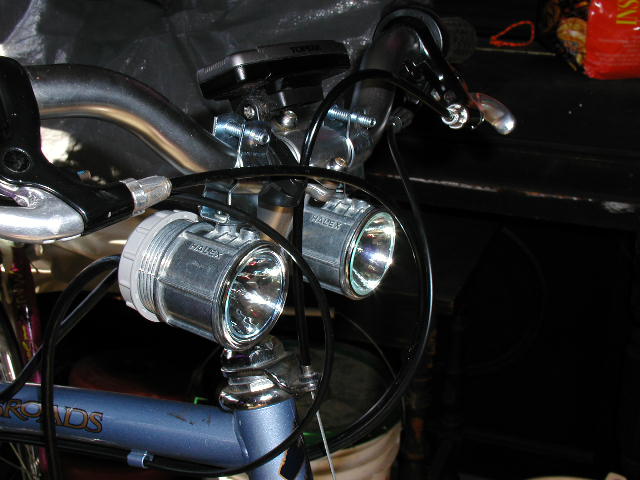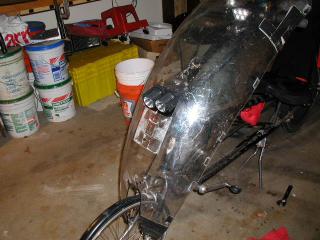Home Depot Bike Headlight
 How to make high power bicycle headlights with materials from your local home center.
How to make high power bicycle headlights with materials from your local home center.
This is an article from a few years back that was up at Bike-Recumbent.com, I'm consolidating everything from there over to here.
Nearly five years after I built them I am still using these headlights with the original bulbs. The 50 watt beam is awesome, oncoming cars always dim their brights when I flash it and it provides plenty of light for the 45 MPH downhill on my way home from work.
– Jake
Disclaimer: Tools used and completed headlights can be dangerous – Dangers range from cuts from knives and power tools, fire and burns from soldering irons and hot bulbs to injury and even death if assembly is swallowed. It's up to you to keep safe.
Components: I'm making a 20 watt low beam and a 50 watt high beam with MR16 Halogen Spot bulbs. Note: Floods don't give you enough range at speed and you want to get the bulbs that have a flat piece of glass at the front. I think most bulbs have this now to act as a UV filter. The NTPF tubing connector pictured worked great as a weather tight strain relief but was a bit bulky. I used a modified faucet washer instead. Other components are 1 1/2" EMT conduit ends, 1 1/2" anti-chafe rings, #0 EMT conduit clamps and female Molex connector pins (from Radio Shack). For a power source I used a 7 Ah gel cell battery of the kind typically found in computer UPSs.
Note: The 50 watt light will be for short duration use only, fast downhills and signaling on-coming traffic to dim hi-beams. A test run of the 50 watt light melted the plastic back and ring and even the solder out of the connectors after about ten minutes. The 20 watt light works well indefinitely, but does get hot enough to be painful to touch.
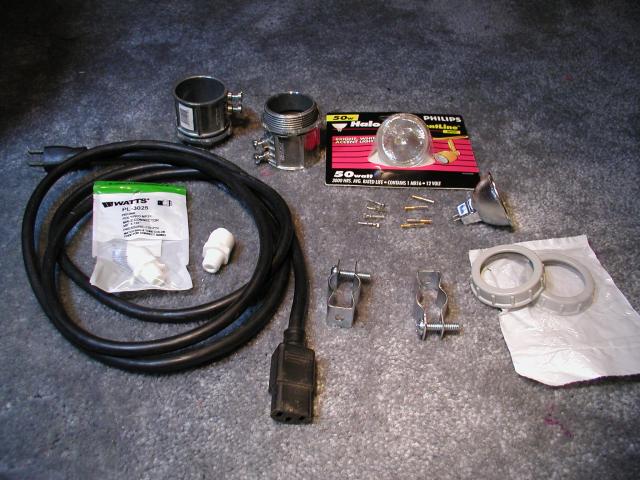
The lamps don't quite fit in the conduit connectors so you'll have to chamfer the inside.

I used a rotary file to do this.

This is also a good time to clean up the screw bosses with a file. You want a good flat surface here as this is where the headlight will be clamped to the mount.
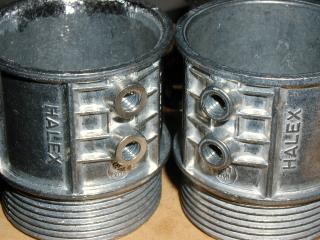

Use a good fat bead of G.E. Silicone II Window and Door sealant to affix the lamp to the housing. Silicone seal is highly heat resistant and tough, but you can dig the lamp out with an X-acto knife to replace it. Let the Silicone Seal cure overnight.
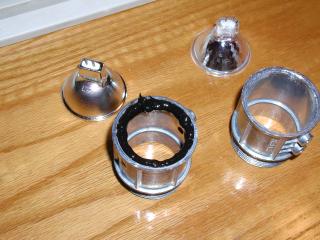
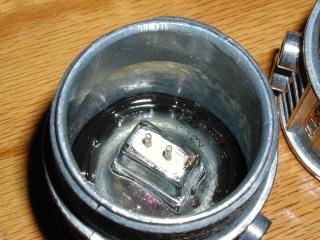
To seal the wire going into the housing I drilled a 1/4" hole through one of these faucet washers and then broke out the bits of hard plastic inside. A tie wrap around the wire just inside the housing completed the strain relief and seal.

I have used Molex pins in the past for this, but I have these lovely mil-spec pins from Cannon. DO NOT solder them on as you see pictured here, there isn't enough room in the housing. Wrap the tinned wire around the barrel of the pin so that it is at right angles to the pin axis. See the assembly picture further down the page.

The back is polyethylene sheet, but could easily be G10 or even aluminum if you're careful about not shorting the pins.

Drill a 3/8" hole for the rubber grommet and check the fit. The image on the right below shows the correct method for soldering the pins.


As you can see the pins are quite close to each other and need to be insulated. This Nashua "Stretch & Seal" Silicone tape is ideal. Cut a 2" strip in half the long way and wrap up the back of the pin and the wire. On my 50 watt test light the melted solder squeezed out from under the undamaged Silicone tape!

Here are the completed lights:

Here they are mounted on a conventional bike and, with a different bracket, on my Toureasy recumbent bicycle.
